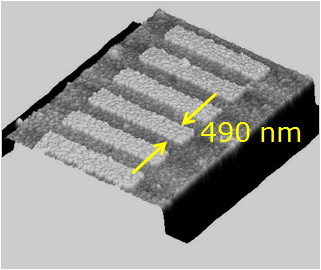



    |
| Periodic arrays of nanomagnets fabricated from Permalloy using either electron beam lithography or focused ion beam patterning. |
|
Individual microscopic magnets have been prepared using electron beam lithography and lift-off processing of polycrystalline Permalloy (Ni80Fe20). Ring-like magnets have in particular turned out to be a "playground" for exploring spin-wave phenomena at the nanoscale. Specific magnetization configurations such as onion and global vortex state give rise to characteristic spin wave modes. They result from different internal field profiles. Using rings in the vortex state we have demonstrated spin-wave interference. Nanolithography was a prerequisite to tailor the magnetic configuration, the quasi-static switching fields and the relevant spin-wave eigenfrequencies.
After fabrication using electron beam
lithography and lift-off processing we used the nanoindentation mode of an atomic force microscope to introduce a
nanopit. The nanopit controlled locally the spin wave eigenfrequency
and wave vector k due to a reduced Permalloy thickness and
demagnetization effects. |
 |
Publications:
[1] Dirk Grundler, Fabian Giesen, and Jan Podbielski:
"Tailoring spin excitations by nanolithography", Physics in Canada
63 (Special Issue: Spintronics), 63 (2007).
![]() [full article (pdf): click here]
[full article (pdf): click here]
[2] J. Podbielski, F. Giesen, M. Berginski, N. Hoyer, and D. Grundler:
„Spin configurations in nanostructured magnetic rings: from DC transport to GHz spectroscopy”, Superlattices and Microstructures 37, 341 (2005). [abstract: click here]
This page is maintained by
e10 - last modified:
26.09.2008